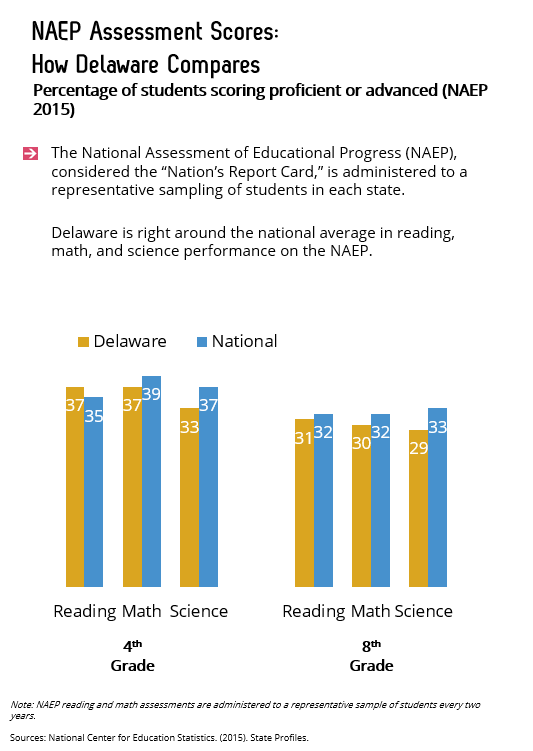Delaware, the U.S., and the Global Report Card: What it Means
An often-unpredictable 2016 came to a close with some status-quo scores and glimmers of promise in science for U.S. students on the Program for International Assessment (PISA), a “global report card” of student achievement.
The PISA is administered every three years to 15-year-old students around the world, assessing their knowledge and ability to think critically in math, reading and science. While student success is about more than just test scores, PISA performance is one of the few benchmarks we have for comparing school systems globally.
Why do we care about the “global report card?”
PISA performance is a bellwether for a country’s economic potential and global competitiveness. Research shows us a strong relationship between school quality and economic growth, as investments in quality public education often translate into workforce quality and fuel for economic growth. Given America’s typical middle-of-the-pack performance, we can view this correlation as an opportunity to cash in on the benefits of education for individuals and society by raising our academic performance to the level of global leaders like Finland, Japan, and Singapore. We can also view it as a threat to America’s economic wellbeing. In the words of the Council on Foreign Relations Task Force Report: “The United States’ failure to educate its students leaves them unprepared to compete and threatens the country’s ability to thrive in a global economy and maintain its leadership role.”
Evidence of equity and excellence. Top performing education systems like Canada, Denmark, Estonia, or Hong Kong (China) achieve high levels of performance and equity in education outcomes, dispelling the myth that equity means sacrificing excellence. There may be opportunities to learn from some of these top-performing education systems as the U.S. continues to struggle with equity and chronic opportunity gaps.
How did U.S. teens measure up to international peers?
Status quo scores in reading and science, with a dip in math. On the whole, there wasn’t anything stunning or shocking about U.S. PISA scores. Among the 35 countries in the Organization for Economic Cooperation and Development (OECD)—comprised of America’s economic peers—U.S. performance in reading and science remained about average, but below average in math. In terms of overall ranking among the 72 participating countries, the U.S. remains close to the middle across all subjects.
The buzz about increased equity in science. While not much has changed in terms of overall student achievement in science, the U.S. has received a lot of attention for narrowing the equity gap. According to the OECD analysis of the influence of socio-economic factors on student performance, equity has improved drastically in the U.S. since 2006—leading other countries in its rate of progress. That being said, the U.S. remains only slightly above average in overall equity and performance in science, as countries like Canada and China continue to demonstrate that leading global education systems can achieve both.
What does U.S. performance mean for Delaware?
We can’t compare apples and oranges. Delaware students don’t take the PISA, and any attempts to compare Delaware to international peers based on statewide assessment results (like the SAT) would be invalid since they test different skills, knowledge, and student populations.
We can make an educated guess by using U.S. results as a proxy for Delaware’s global competitiveness. Given that Delaware students performed on par with students nationally on the NAEP, our best guess is that it is likely that U.S. results on the PISA reflect how Delaware students would perform if Delaware administered the assessment. Massachusetts’ leading performance on both the NAEP and PISA suggests that if Delaware could surpass Massachusetts, we would rank among the top 10 global education systems. This hypothesis is supported by an analysis by Erik Hanushek, cross-walking states’ 2012 NAEP results and countries 2011 PISA scores.
Student Success 2025: A Path Forward for Delaware
The Student Success 2025 plan outlines several measures of success, including NAEP. At the end of the day, academic achievement is just one of them. In order to become a national and global leader in education, we must ensure Delaware children are prepared with the skills and attributes to thrive beyond by implementing Delaware’s vision for education—Student Success 2025.
The 2016 progress report highlights important progress from pre-k through postsecondary, and outlines short-term priorities for progress moving forward. Learn more about Student Success 2025 and Delawareans’ big ideas for implementation.





